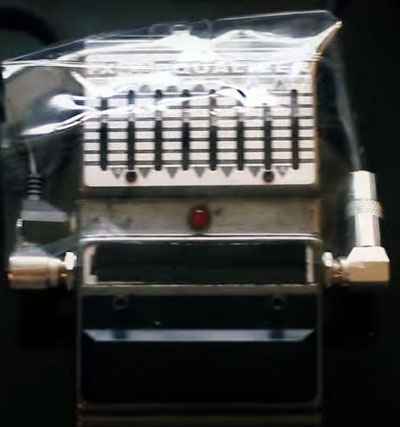This guide will look at Tom Morello’s guitar rig during his Rage Against the Machine years. His rig slightly changed during Audioslave so check this guide out to learn about his rig during Audioslave.
Tom Morello’s Guitars during RATM
You might be interested to hear that Tom doesn’t really care about high quality guitars. As he explains in the video below, many of the guitars he used throughout his career were purchased really cheap and didn’t have the best hardware.
This is an important point as many people get overly focused on getting the best possible guitar hardware possible. As Tom explains in many interviews, worrying too much about your gear takes away from thinking about the music.
The ‘Arm the Homeless’ guitar (shown to the right) was extensively used throughout Rage Against the Machine. It’s a guitar Tom pieced together and includes an Ibanez Edge Floyd Rose, a Les-Paul style toggle switch and a knock-off Kramer neck. It uses EMG H (neck) and EMG 85 (pickups). 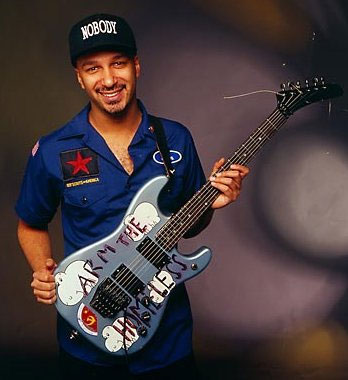
Tom’s other guitar worth mentioning is a cheap Fender Telecaster which he used for Drop-D tuning. As he explains in the video above, he traded an amp head for it simply to have a guitar that could easily go into Drop-D tuning.
The key lesson with Tom and his guitars is that you can achieve a great tone with essentially anything. If you’re reading this to find out what type of guitar you should buy to get a great RATM tone, here are a few points to keep in mind:
- You will want either a Les Paul style toggle switch with separate volume controls for each pickup or a guitar with a killswitch (explained later)
- The choice between a Floyd Rose style bridge and a fixed bridge is up to you. Find out more about Floyd Rose bridges in my ultimate guide here before you decide to get a guitar with one
- Pickups don’t matter
Killswitch/Toggle switch
An important aspect of Tom’s unique style is the use of a killswitch. The idea with a killswitch is that you can use it to instantly cut the guitar tone or rapidly turn the guitar on and off. This is similar to what you would achieve with a tremolo pedal but a killswitch allows you to have complete control over the speed and rhythm of the tremolo effect.
The intro to Know Your Enemy is a great demonstration of how Tom uses the killswitch:
Another great example is the solo for Bulls on Parade where Tom uses the killswitch to imitate a DJ:
You have two main ways to achieve this:
1. Use a guitar with a Les Paul style toggle and independent volume knobs
If your guitar has a volume knob for each pickup and a three-way selector, you can simply roll the volume of one of the pickups to zero and the volume for the other pickup at maximum. Then when you toggle between the two pickups it will cut in and out. This is exactly what Tom does on his red and black Ibanez Artstar guitar.
2. Install a killswitch
It’s quite easy to install a killswitch into your own guitar. This is what Tom does on his guitars that don’t have two separate volume knobs (in the photo earlier with the ‘Arm the Homeless’ guitar you can see he installed a toggle switch).
If you want to install your own killswitch, you have two main options. You can either install a two-way toggle switch or a momentary button. Either one will do the same job but they feel different to use. The toggle switch you grab and move rapidly up and down which is what Tom does. The momentary button you simply tap when you want your tone to cut out. Everybody is different so I recommend trying out a guitar with a momentary killswitch already installed and compare it to a toggle to see which you prefer.
The below link shows a momentary killswitch. You can see it’s quite cheap to modify your guitar to add a killswitch. Check out the price, wiring diagram, and details of the below chrome killswitch here.

Tom Morello’s Amp and Cabinet
Tom has used a 50 watt Marshall JCM 800 2205 head throughout his entire RATM and Audioslave career. While you can see in the earlier video that he does have different amps in his studio, when it comes to live use, it’s always a JCM 800. While the JCM 800 has two channels, Tom only uses the overdrive channel (as explained later).
Tom’s uses a straight-front Peavey 4×12 cabinet similar to this Peavey cabinet as shown below.
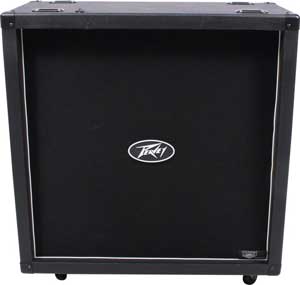
The truth is you can pretty much achieve a Tom Morello tone with almost any amp and cabinet. As Tom explained in the video, the Grammy award-winning song ‘Tire Me’ was recorded on a 20-watt solid state amp with a cheap no-name guitar.
So as long as the amp you use has a nice overdrive – you’ll be able to get pretty close to a Tom Morello tone. Of course, if you own a Marshall you’re going to get closer, but don’t feel you need to have the exact same amp.
Tom Morello’ RATM Pedalboard Breakdown
The below photo shows Tom Morello’s pedalboard from his days in Rage Against the Machine. Let’s look at each pedal, how he chains his effects together (important) and then how he uses each one.
The photo below shows Tom’s pedalboard throughout Rage Against the Machine. Considering the diverse range of sounds he achieved throughout those albums, it might surprise you how minimal his pedalboard really is.
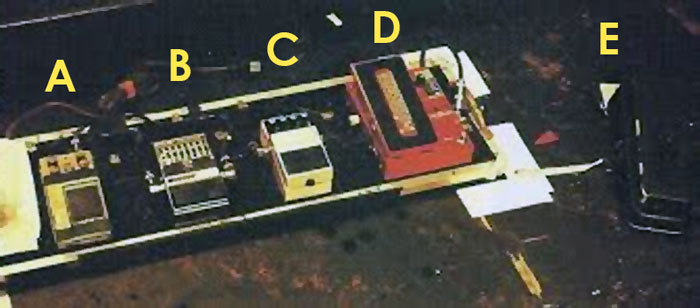
A: Ibanez DFL Flanger
The Ibanez DFL Flanger was the first digital flanger produced and is well known among Tom Morello fans. Unfortunately, they’re a bit difficult to get a hold of today and if you do find one you’re likely to pay a high price for it. Tom used a flanger in songs such as Killing in the Name (the first opening chord), Guerrilla Radio, Wake up and Freedom. The flanger is set to slow and wide and listening to the start to Killing in the Name is a great way to dial in the right speed on your flanger.
Alternatives to the Ibanez DFL Flanger:
- Boss BF-3 Flanger – this is a very popular flanger with a thick tone. It gives you a variety of modes and control so you will definitely be able to dial in the exact flange effect you want. I recommend this option if you don’t already have a flanger.
- MXR M152 Micro Flanger – this pedal only has two control knobs so you’re not going to get quite the same level of control compared to the BOSS.
- MXR Phase 90 – this isn’t a flanger but it produces a similar effect. The only reason it’s listed here as an alternative is that at some point in Tom’s Audioslave career, he replaced the Ibanez DFL with an MXR Phase 90. So while they’re two very different effects, it could passably be used instead of a flanger. Although keep in mind the MXR Phase 90 only has one control knob while the BOSS has four knobs so you’re not going to have much control over the effect with this option. My recommendation is to get a proper flanger and consider this as an additional pedal if you also want to use it for Audioslave songs.
While the flanger doesn’t show up very often, it produces a very distinctive sound so I highly recommend getting a flanger if you want to get a guitar sound like Tom Morello. Playing the start of Killing in the Name with the flanger on makes all the difference.
B: DOD FX40B EQ
Not many guitarists use Equalizer pedals and it’s surprising to see it on Tom’s pedalboard. In fact, he didn’t even use this as a proper EQ pedal. He sets the EQ flat then raises the Level slider to give his sound a boost. So Tom really uses this pedal as a booster for solos. Tom continued to use the DOD FX40B throughout his Audioslave career in the same way.
While you could buy any EQ pedal for this purpose, I would recommend buying a real booster pedal. That way you have control over the type of boost you use.
The close-up below was taken from the video earlier and shows the settings Tom uses on his DOD FX40B:
As you can see it is almost completely flat. There is a slight dip in the fifth slider from the left which is the 800Hz band. But you can see overall it’s a very flat setting with the aim of using it simply as a booster. The plastic over the pedal is simply there to protect the pedal from sweat or rain falling in the slots during live use.
Alternatives to the DOD FX40B:
- Xotic EP Booster – this is an incredibly popular booster pedal because it produces an excellent quality boost with up to 20dB of gain. Internal Dip switches allow you to customize the boost to your liking. I highly recommend this option.
- MXR 10 Band Graphic EQ – if you do want to use an EQ pedal, the extra benefit is that you can actually use it as an EQ pedal whenever you want to tweak your tone.
So my recommendation here is to buy a booster pedal if you want to boost your solos just like Tom uses his DOD FX40B. Alternatively, an EQ pedal is incredibly useful and can help you fine-tune your tone if you use it as an EQ pedal instead of a booster.
C: BOSS DD-2 Digital Delay (switched to a DD-3 later on)
Delay is such a common effect yet Tom still manages to get the most out of it. In a song such as Testify, he sets his delay to a very fast slapback with high feedback to basically produce a reverb-like effect. You will hear a slapback type delay used quite often as it is a great way to thicken up his tone.
Tom used a BOSS DD-2 Digital Delay and eventually switched over to a DD-3 which is essentially the same pedal. So don’t bother looking for a DD-2 as the DD-3 will do the same job.
The close-up below was taken from the video earlier and shows the settings Tom uses on his BOSS DD-3:
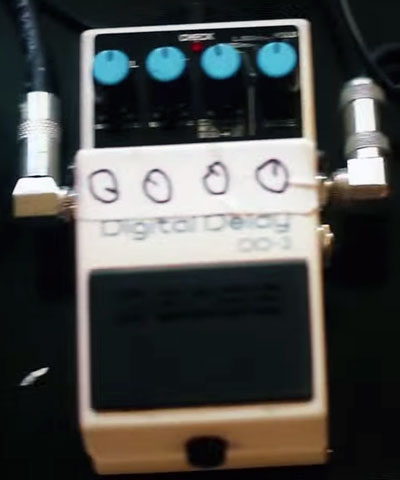
The sticker shows settings he uses although it’s likely to change depending on the song played. So use the above settings as a good starting point, then experiment with changing the settings for each RATM song you play. It’s interesting to point out that the effect level is cranked up and he uses the ‘Long’ delay mode.
Check out the BOSS DD-3 here for price and details.

D: Digitech WH-1 Whammy
This is the crucial pedal you should buy if you want to sound like Tom Morello. It’s such an iconic effect and Tom really gets the most out of it. Solos in Know Your Enemy, Bullet in the head, Ashes in the fall and Killing in the name all get their distinctive sound thanks to the Digitech Whammy.
Check out my Whammy Pedal lesson here to learn how to use the whammy as Tom does on many RATM tracks.
If you don’t already have a Digitech Whammy, it really is a pedal worth buying. When it comes to songwriting and coming up with new ideas, it’s a great source of inspiration. You can see from above there is a wide range of different settings from simple pitch shifting to harmony and detuning. It would be hard to reproduce a lot of Tom’s unique solos without a Whammy.
There are a few different Whammy models but the above model is the reissue of the original which is what Tom uses. While you can definitely use that pedal to achieve all of Tom’s whammy effects, I recommend the DigiTech Whammy DT instead. It contains more features which are missing on the above whammy. Check out my review on the DigiTech Whammy DT here.
E: Dunlop Cry Baby
If you had to pick two pedals to buy to replicate Tom’s sound, it would definitely have to be a Digitech Whammy and a Wah pedal. Used in songs such as Bulls on parade, Guerrila Radio and No shelter, the wah adds such color to Tom’s tone. Tom uses a simple Dunlop Crybaby although you can basically use any wah pedal and achieve the same results.
Check out my Wah Pedal lesson here to learn how to use the wah pedal.

My recommendation is to buy a wah pedal that suits your needs rather than buy the Cry Baby simply because that’s what Tom uses. For example, I prefer a wah pedal with extra control over the tone which is why I use a Vox Big Bad Wah (read my review here). Alternatively, if you’re looking for a basic option, check out my review of the Original Crybaby here.
What Pedals Tom Morello Doesn’t Use
It’s surprising to see how few pedals Tom uses when you consider the wide range of different sounds he creates in RATM songs. While Tom no doubt experimented with a lot of different pedals over the years, he has basically kept his pedalboard the same over the last few decades (with a few small changes during Audioslave).
It’s worth pointing out that Tom doesn’t have a distortion/overdrive pedal. His higher gain tone comes from his amp’s overdrive channel. You can also see that he doesn’t have a channel footswitch for his amp. That’s important to remember because it means to achieve a clean tone, he uses the amp’s overdrive channel then rolls off the volume on his guitar. So even though the JCM 800 does have two channels, Tom only uses the one.
So for example when you want to reproduce the clean tone at the start of Bombtrack, instead of using a clean channel on your amp, use your regular high gain settings then roll the volume off of your guitar. You will achieve a warmer tone that may or may not have a bit of dirt depending on how much gain you use. In the studio, he most likely used a clean channel so you could do the same – but from a live point of view, everything is done with one channel.
RATM Pedalboard Rig Setup
Here is how Tom chained all the pedals together during RATM:
Guitar > Amplifier
Amp FX Send > Dunlop Crybaby > Digitech Whammy > BOSS DD-2 > DOD FX40B > Ibanez DFL > Amp FX Return
This is a very different approach to how many guitarists set up their rig. This rig makes full use of the amp’s effects loop and all pedals are placed in the loop. Most guitarists have pedals in front of the amp as well as in the effects loop.
If your amp has an effects loop, try placing all pedals there then place all of them in front of the amp so you can hear how it changes the tone. You may prefer your pedals in front of your amp or you may prefer them in the effects loop. You may also want to experiment with placing individual pedals in front of the amp such as the wah. Most guitarists place the wah in front of the amp so experiment with both positions to hear how it shapes your tone.
Key Principles to Remember
Here are a few key principles to keep in mind when trying to recreate a tone like Tom Morello. Learning how Tom thinks about his gear and music will also help you grow as a guitarist.
Quality isn’t that important
Guitarists often get too tied up in getting the best gear possible and having super high-quality guitars. Tom openly admits to how many of his guitars are far from perfect. In the video earlier he talks about recording the entire first RATM album on a pawn shop guitar through a 20-watt solid state amp. He also keeps the original pickups on many guitars and openly admits some guitars don’t hold tune or have a ruined tone due to his modifications. This approach is almost completely opposite to many guitarists who obsess about upgrading their pickups or other hardware.
The quality of the gear isn’t as important as what you do with the gear. Get the most out of the gear you have. Experiment with every pedal you have a try to find as many different creative uses for it as you can. If you buy a Digitech Whammy, don’t just use it to shift your pitch up an octave using the pedal. Experiment with the harmony settings or the detune mode. Combine the effect with other pedals and see what you can do with it.
Don’t look for a perfect tone
If you’re currently trying to buy the right gear to give you the perfect tone – stop. As Tom explains, after he gave up looking for the perfect tone, it gave him a lot of freedom to focus on writing music. That’s why he has kept his rig essentially the same over the last few decades.
Try a different approach to everybody else
Tom Morello’s unique approach to guitar is the result of seeing the 80’s hair metal bands and wanting to be different. Instead of playing fast sweep picked arpeggios and tapping, Tom experimented with making his guitar sound like a DJ’s turntable. Take a look at what you like and dislike about guitarists/music today and experiment with trying something different.
I’ll be creating some lessons and guides shortly on specific RATM songs so subscribe to my newsletter to stay up to date with new lessons.
To find out about the changes he made to his rig during Audioslave, check this guide out.
Found this guide useful? Please share it on social media to help support this site (if you use Pinterest, please pin the below photo).




